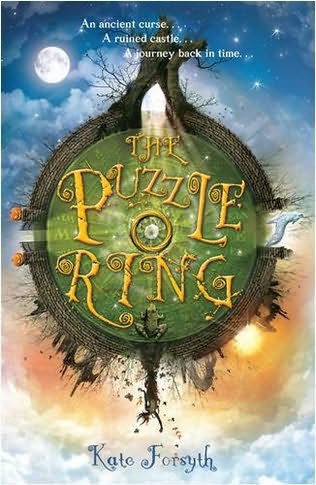 Today we welcome Aussie Author, Kate Forsyth, who will share with us how she got the inspiration for her latest book, The Puzzle Ring.
Today we welcome Aussie Author, Kate Forsyth, who will share with us how she got the inspiration for her latest book, The Puzzle Ring.The inspiration for ‘The Puzzle Ring’
People always ask me where I get my ideas from.
Llike most writers, I find
 this a difficult question to give an easy answer to. You need lots and lots of ideas to create something as complex and sophisticated as a novel. Some ideas just come like a flash of lightning. Other ideas you have to find with a whole lot of digging, like a miner scrounging in the dirt for opals.
this a difficult question to give an easy answer to. You need lots and lots of ideas to create something as complex and sophisticated as a novel. Some ideas just come like a flash of lightning. Other ideas you have to find with a whole lot of digging, like a miner scrounging in the dirt for opals.I normally need two or three strong ideas before I know I’ve got a novel on my hands. I start with one, which can come from anywhere – an overheard conversation, something I read about in a book, a stray thought that pops into my head while I’m doing the washing up – and then I think about it for a while. I might put it together with a few other ideas I’ve had and see if they seem to belong together.
The very first idea for this novel came when I was waiting bored in a doctor’s surgery. Unusually for me, I hadn’t brought a book to read and so I flicked through a few gossip magazines, then picked up a jewellery catalogue. It was mainly pictures and not much text, but on the back page it had a very brief history of the puzzle ring, which I found fascinating.
Basically, the article said that the puzzle ring was first invented by an Arabian king who was mad with jealousy over his young and beautiful wife. He challenged a jeweller to make a wedding ring that would show if the ring was ever taken off his wife’s finger. After many attempts, the jeweller invented a ring that would fall apart into separate loops if removed from the finger, and could only be put back together again if you knew the secret of the puzzle. Of course, the wife did take the ring off one day ... and was promptly killed by her furious husband.
I thought at once, in an idle sort of a way, what a great thematic device this would be for a quest story ... a desperate search for a puzzle ring that had fallen apart. When I got home, I wrote it down in my ideas book but that was all I did with the idea for quite a long time, as I was very busy writing my historical adventure novel ‘The Gypsy Crown’. Every now and then, though, I’d wonder ... WHO would be searching for a puzzle ring? WHY?
Then one day I was browsing in a second-hand bookstore and discovered an old book called ‘The Book of Curses’. When I sat down to look through it, the page fell open, of its own volition, at a chapter about the famous Scottish curse ‘The Seaforth Doom’. This is a very chilling and creepy story about a warlock called Kenneth the Enchanter who was burnt to death in the 16th century by a jealous and vengeful woman, Isabella, the Countess of Seaforth. Kenneth had a magical fairy stone, or hag-stone, and the countess had asked him to look through his hag-stone and tell him what her husband was doing. Kenneth had laughed, and then told her "Fear not for your lord, he is safe and sound, well and hearty, merry and happy". Angrily she demanded to know why he had laughed, and when he would not tell her, threatened him with a terrible death. At last he confessed he had seen her husband on his knees before another woman, kissing her hand. The countess was so furious that she ordered Kenneth to be thrust headfirst into a barrel of boiling tar. As he was led out to his execution, the warlock lifted his hag-stone to his eye and cast a terrible curse on the Mackenzies of Seaforth.
This is what he said:
‘I see into the far future, and I read the doom of the race of my oppressor. The long-descended line of Seaforth will, ere many generations have passed, end in extinction and in sorrow.
I see a chief, the last of his house, both deaf and dumb. He will be the father of four fair sons, all of whom he will follow to the tomb. He will live careworn and die mourning, knowing that the honours of his line are to be extinguished forever, and that no future chief of the Mackenzies shall bear rule ... the remnant of his possessions shall be inherited by a white-hooded lassie from the East, and she is to kill her sister.
And as a sign by which it may be known that these things are coming to pass, there shall be four great lairds ... one shall be buck-toothed, another hare-lipped, another half-witted, and the fourth a stammerer.
(They) shall be the allies and neighbours of the last Seaforth; and when he looks around him and sees them, he may know that his sons are doomed to death ... and that his race shall come to an end.’
Kenneth the Enchanter then threw away his magical hag-stone and was cruelly killed.
The curse had been cast against the wife of the third Earl of Seaforth. Apparently she only laughed at Kenneth’s words and micked him. For several generations all seemed well.
Then the ninth Earl of Seaforth, called Francis Humberton Mackenzie, was born in 1794. An attack of scarlet fever when he has twelve left him deaf, but he still married and in time had four sons and two daughters. Among his friends and neighbours were four great lords, one of which was buck-toothed, one had a cleft palate, another stammered and the fourth, unfortunately, was not very bright.
One by one his sons died, and in his grief the Earl turned his face to the wall and would not speak. He died soon afterwards, leaving only his two daughters. The elder, Mary Mackenzie, had married a man called Sir Samuel Hood who lived in the East Indies. Recently widowed, she returned from the East to take possession of the estate wearing her widows’ weeds – a black dress and white cap – and named Lady Hood, an uncanny fulfilment of the prophecy. Some time later, while driving her sister out in her carriage, the ponies took fright and both sisters were thrown out. The younger sister was killed.
So did the Seaforth Doom come at last to pass.
As soon as I read this story, which is very famous indeed in Scotland, I was electrified. What must it have been like, I thought, to be Francis Humberton Mackenzie, living out his life with that shadow hanging over him? Having four sons and hoping the curse could not be true. Imagine what it must have been like to be those two sisters, knowing one must kill the other. I bought the book, and as I walked back to my car, my brain was on fire. I saw the whole story unfolding in my mind’s eye ... a jealous husband, a puzzle ring, a faithful wife tricked into taking the ring off, the curse she casts on the castle as she dies ... and then generations later, a girl who decides she must break the curse and sets out on a perilous quest to find the four lost loops of the puzzle ring...
And that is how I came to write ‘The Puzzle Ring’.
***********
Thanks Kate for sharing that awesome anecdote! Now I really want to read this!
If you'd like to read the other posts for Kate's International Blog Tour, here are the links:
- 01/02/2010 - The Bookette
- 02/02/2010 - What Kate Did Next
- 03/02/2010 - Chicklish
- 04/02/2010 - Once Upon A Bookcase
- 05/02/2010 - Chicklish
- 06/02/2010 - I was a teenage book geek
- 07/02/2010 - I was a teenage book geek
- 08/02/2010 - The Bookette
- 09/02/2010 - Tales of Whimsy (and a book review at Bookalicious Ramblings)
- 10/02/2010 - Nayu's Reading Corner
- 11/02/2010 - ejly - literate mother tecnhologist
- 12/02/2010 - So Little Time for Books
- 13/02/2010 - Ultimate Bookhound
- 14/02/2010 - Bookalicious
- 15/02/2010 - The Book Bug
- 16/02/2010 - Alan Baxter
- 17/02/2010 - I want to read that
- 18/02/2010 - The Story Siren
- 19/02/2010 - Wondrous Reads
- 20/02/2010 - ChickLit
- 21/02/2010 - Steph Bowe
- 22/02/2010 - Me & My Big Mouth
- 23/02/2010 - Tales of Whimsy
- 24/02/2010 - Seven Miles of Steel Thistles
- 25/02/2010 - Seven Miles of Steel Thistles
- 26/02/2010 - My Fluttering Heart
- 27/02/2010 - Bookworming in the 21st century
- 28/02/2010 - The Clock Monkey



2 monkey thought (s):
Thanks for listing me :) FAB post :)
Became a follower!
Post a Comment